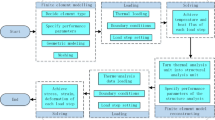Abstract
A 3D thermomechanical finite element analysis model for laser tube bending is developed based on the software MSC/Marc. The processes of single- and multi-scan are analyzed numerically. The gradient and development of the temperature between the laser scanning side and the nonscanning side leads to the changing complexity of the stress and strain. Consequently, the length of the laser scanning side becomes shorter than that of nonscanning side after cooling. The length difference between both sides makes the tube produce the bending angle. The relationship between the number of scans and the bending angle is about in direct ratio. The bending angle induced by the first irradiated time is largest. Meanwhile, the finite element simulation is integrated with the genetic algorithm. Aiming at different process demands, corresponding objective functions are established. Laser power, beam diameter, scanning velocity, and scanning wrap angle are regarded as design variables. Process optimizations of maximum angle bending and fixed angle bending after single laser scan are realized. Groups of optimized process parameters can be obtained according to different optimization objectives. The bending angle can approach to the maximum when the laser power, spot diameter, scanning velocity, and scanning wrap angle are 381.24 W, 3.37 mm, 16.34 mm/s, and 123.1°, respectively. When the laser power, spot diameter and scanning velocity are 426.12 W, 4.9 mm, 14.31 mm/s respectively, a fixed angle bending can be achieved.
Similar content being viewed by others
References
Geiger M, Vollertsen F (1993) The mechanism of laser forming. CIRP Ann 42:301–304
Arnet H, Vollertsen F (1995) Extending laser bending for the generation of convex shapes. J Eng Math 209:433–442
Yang L, Wang M, Wang Y, Chen Y (2010) Dynamic analysis on laser forming of square metal sheet to spherical dome. Int J Adv Manuf Technol 51:519–539
Xia M, Yan Q, Zuo D, Xie J (2011) An investigation on multistage bending of blank sheet into cylindrical tube by experiment and numerical simulation. Int J Adv Manuf Technol 53:145–155
Hao N, Li L (2003) Finite element analysis of laser tube bending. Appl Surf Sci 208–209:437–441
Hao N, Li L (2003) An analytical model for laser tube bending. Appl Surf Sci 208–209:432–436
Hsieh H, Lin J (2005) Study of the buckling mechanism in laser tube forming. Opt Laser Technol 37:402–409
Hsieh H, Lin J (2005) Study of the buckling mechanism in laser tube forming with axial preloads. Int J Mach Tool Manuf 45:1368–1374
Zhang J, Cheng P, Zhang W, Graham M, Jones J, Jones M, Lawrence Yao Y (2006) Effects of scanning schemes on laser tube bending. J Manuf Sci E-T ASME 128:20–33
Safdar S, Li L, Sheikh MA, Zhu L (2007) Finite element simulation of laser tube bending: Effect of scanning schemes on bending angle, distortions and stress distribution. Opt Laser Technol 39:1101–1110
Guglielmotti A, Quadrini F, Squeo EA, Tagliaferri V (2008) Diode laser forming of stainless steel tubes. Int J Mater Form (SUPPL.1): 1343–1346
Vollertsen F, Holzer S (1995) 3D-thermomechanical simulation of laser forming, simulation of materials processing: theory, methods and applications. In: Dawson PR (ed) SF Shen. Balkema, Rotterdam, pp 785–791
Xie H, Xu X, Liu X, Wang G (2005) Numerical simulation on hot strip temperature field in laminar cooling process. J Iron Steel Res 17:33–35,50 (in Chinese)
Davis JR (1990) Metals handbook Vol.1. ASM International Ohio
Davis JR (1990) Metals handbook Vol.2. ASM International Ohio
Tan Z, Guo G (1994) Thermal-physical properties of alloys (in Chinese). Metallurgical Industry Press, Beijing
Mitsuo G, Runwei C (2000) Genetic algorithms and engineering optimization. Wiley, New York
Lihong Q, Shengping L (2012) An improved genetic algorithm for integrated process planning and scheduling. Int J Adv Manuf Technol 58:727–740
Author information
Authors and Affiliations
Corresponding author
Rights and permissions
About this article
Cite this article
Guan, Y., Yuan, G., Sun, S. et al. Process simulation and optimization of laser tube bending. Int J Adv Manuf Technol 65, 333–342 (2013). https://doi.org/10.1007/s00170-012-4172-6
Received:
Accepted:
Published:
Issue Date:
DOI: https://doi.org/10.1007/s00170-012-4172-6




